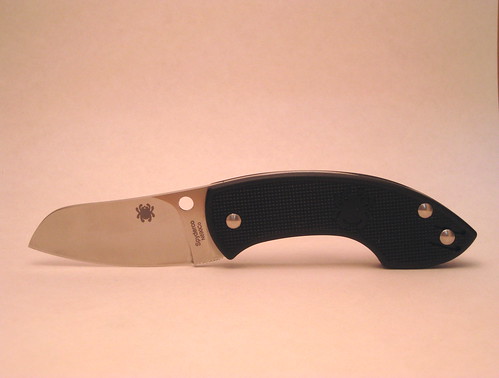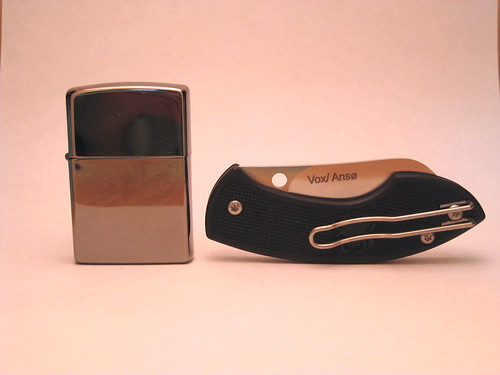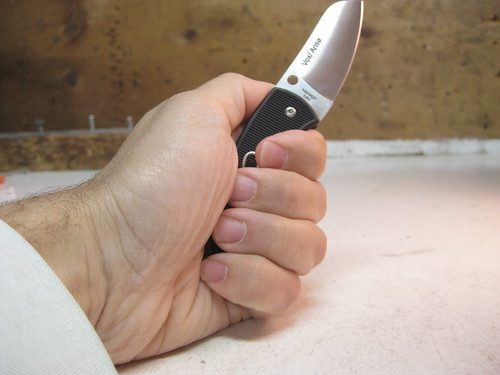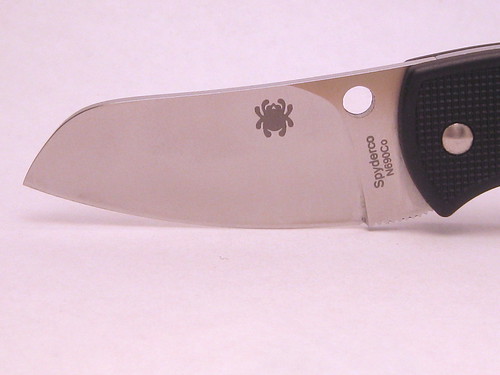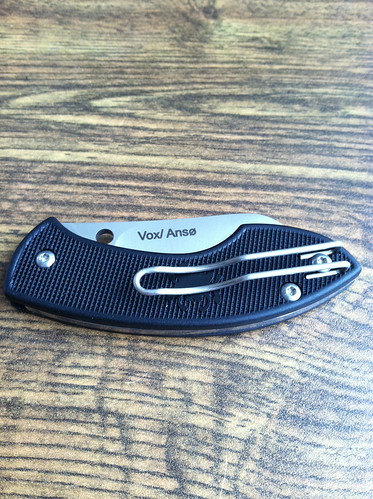Spyderco Pingo Review
There are rare geniuses that are appreciated in their time. Most, it seems, require the tidal forces of time to pass over their work before the collective can see the brilliance. In the knife world, we are fortunate that the design talents of Jens Anso (pronounced Yens Ansoo, with the "Y" making the same sound as it does in the word "Yes") were almost immediately recognized. The blade shapes, the grip pattern, and the asymmetrical grinds are all highlights of Anso's design talents.
A collaboration then between Anso and Spyderco, a company founded by a guy with some pretty impressive design chops himself, seemed like an almost inevitable thing. First there was the Rock Lobster, then the Zulu and most recently the Pingo. The Pingo is by far the easiest to carry of those knives, both in terms of its physical dimensions and also in terms of its legality. This knife is a three way collaboration between Jens Anso, Jesper Voxnaes, and Spyderco. It was designed to be legal in Denmark and thus it "requires" two hands to open and is a non-locking knife, more on this below. The Pingo is distinct and different. The question is whether that difference is good and whether it is good enough to overcome the lack of a lock and one hand deployment. Put another way--in a country where you can carry locking knives that open with one hand, is the Pingo STILL good enough to carry?
The answer is an unqualified yes. This is a superb knife.
Here is the product page. The Pingo costs around $50. There are two variations--a black handled version and an orange handled version. Here is a written review. Here is a video review. Here is a link to Blade HQ, where you can find the Pingo, and all proceeds benefit the site when you purchase things through this link:
Blade HQ
Here is my review sample:
Twitter Review Summary: Being lockless and two hands required can't sink the Pingo with its perfect size, weight, and unbeatable blade shape.
Design: 2
Steel: 2
Blade Shape: 2
Deployment Method: 0
Retention Method: 2
Blade Safety: 1
A collaboration then between Anso and Spyderco, a company founded by a guy with some pretty impressive design chops himself, seemed like an almost inevitable thing. First there was the Rock Lobster, then the Zulu and most recently the Pingo. The Pingo is by far the easiest to carry of those knives, both in terms of its physical dimensions and also in terms of its legality. This knife is a three way collaboration between Jens Anso, Jesper Voxnaes, and Spyderco. It was designed to be legal in Denmark and thus it "requires" two hands to open and is a non-locking knife, more on this below. The Pingo is distinct and different. The question is whether that difference is good and whether it is good enough to overcome the lack of a lock and one hand deployment. Put another way--in a country where you can carry locking knives that open with one hand, is the Pingo STILL good enough to carry?
The answer is an unqualified yes. This is a superb knife.
Here is the product page. The Pingo costs around $50. There are two variations--a black handled version and an orange handled version. Here is a written review. Here is a video review. Here is a link to Blade HQ, where you can find the Pingo, and all proceeds benefit the site when you purchase things through this link:
Blade HQ
Here is my review sample:
Twitter Review Summary: Being lockless and two hands required can't sink the Pingo with its perfect size, weight, and unbeatable blade shape.
Design: 2
Anso's designs are truly, utterly ground breaking. So ground breaking, in fact, that yours truly missed them entirely. I took one look and assumed that they were weird for the sake of weird, but the buzz around Anso just never died so I couldn't just ignore them. The Rock Lobster was too big and all of the Boker stuff is...well...Boker stuff. So when the Pingo dropped I knew I needed to grab one and...it was a complete and utter revelation. Anso is AWESOME.
This knife is such a nice, easy on the hand, easy on the pocket knife. It cuts and cuts well. It can handle jobs, thanks to the unusual blade shape, that most pointy knives can't or shouldn't. The overall look and feel is polished and smooth, like a river rock in your hand. Talking with Mr. Anso in preparing for this article, he indicated that the design was both his and Mr. Jesper Voxnaes in equal parts, but the blade shape seems very clearly to be an Anso pattern, especially when compared to the Rock Lobster.
The Pingo is right around my favorite size for a pocket knife--between a 2.5 and 3 inch blade. The lack of a lock is not that much a weight saver as the backspring is basically the same as you would find on a lockback knife. With that said there are no liners so this is a feather of a blade. It is also a very compact blade when folded up:
The ratios are at opposite ends of the spectrum. The blade:handle is .68, which is quite bad. Only the Delica and a few other designs had a blade/handle that far off. One issue that makes me think this isn't a fatal flaw is the fact that in a knife this small, a comfortable handle has to be of a certain size even if the blade is tiny. The blade:weight is 1.24, very good among the knives I have reviewed. The bulk of the weight savings comes from the lack of liners, but there are other weight savings--FRN handles, a good wire clip, and a not-so-bulky blade stock.
The ratios are at opposite ends of the spectrum. The blade:handle is .68, which is quite bad. Only the Delica and a few other designs had a blade/handle that far off. One issue that makes me think this isn't a fatal flaw is the fact that in a knife this small, a comfortable handle has to be of a certain size even if the blade is tiny. The blade:weight is 1.24, very good among the knives I have reviewed. The bulk of the weight savings comes from the lack of liners, but there are other weight savings--FRN handles, a good wire clip, and a not-so-bulky blade stock.
There are two design quirks you need to know going in--this is a knife made to comply with Danish knife laws which are some of the most restrictive in the world. There is no lock, as I have already mentioned, and the knife cannot be opened with one hand absent some serious finger yoga. This is a most extreme design, even for Spyderco, a company that has a truly global approach to knives with a plethora of Slip-It non locking designs. This is, to my knowledge, the only two hand open, non-locking knife Spyderco has ever made.
Fit and Finish: 2
There is a rounded edge to the mild checked handle that is largely responsible for the comfy, in-hand feel. But the fit and finish here is top notch (this is a Magiano, Italy produced knife, so you know the quality will be there). The grind is a dished out grind. The jimping on the bottom of the blade is well cut. The knife came centered. The blade's satin finish was quite nice. Everything, it seems, just works:
As unusual as this knife is in terms of design, its fit and finish is highly conventional and utterly superb given the price.
Fit and Finish: 2
There is a rounded edge to the mild checked handle that is largely responsible for the comfy, in-hand feel. But the fit and finish here is top notch (this is a Magiano, Italy produced knife, so you know the quality will be there). The grind is a dished out grind. The jimping on the bottom of the blade is well cut. The knife came centered. The blade's satin finish was quite nice. Everything, it seems, just works:
As unusual as this knife is in terms of design, its fit and finish is highly conventional and utterly superb given the price.
Here is a warning for those of you that are coming to the Pingo from a traditional knife perspective--this is nothing like the slender, taut, fingers of steel and bone you are used to. First, this knife feels light. It is wider than you are used to and it has no nail nick at all. Additionally because of the FRN handles, that distinctive click of the "talk" part of "walk and talk" just isn't that impressive. The "walk" part is fine. This is not a modernized traditional knife, it is something differently entirely.
Grip: 2
Here is the knife in my medium sized hand:
Carry: 2
Here is the knife in my medium sized hand:
It is not a massive blade, by any means, but it is, nonetheless pretty darn good in the hand. Thanks to the little hook at the end of the handle, my first two fingers fell into place with my third finger resting atop the raised portion of the handle just behind the hump. This is an excellent grip for a three finger knife.
Carry: 2
This knife carries like a dream. The combination of a deep carry, over the top wire clip (one of my favorite clips) and the rounded and polished edges make this a knife that an absolute dream in the pocket. The front hump is not offensive in the least, and the overall weight doesn't make this a leg banger. If you are going to make a knife without a lock that requires two hands to open you need to make up for it somewhere and this is where Vox and Anso did it.
Steel: 2
The N690 steel is actually quite good. Similar too, but a step above VG-10, N690 is probably as nice a steel you can get without stepping up to powder metallurgy. It is a European steel that has seen a much more prominent role in high end cutlery recently. For example, Dave Curtiss's uber successful F3 series of knives, the so-called Hinderer killers--uses N690.
This is one of those cases where the wisdom of crowds is actually correct. In my two weeks with the Pingo the N690 steel maintained a razor edge. It performed general EDC tasks and some harder tasks as well. Two things in particular highlighted the steel's very good edge retention. First, I made some kindling and roasting sticks with the Pingo and the N690 retained virtually all of its edge. Second, I used the Pingo to modify bottle tops for my three year old son. Most modern day bottles have tremendously thick plastic around the caps and the Pingo dug into that material with ease and again still maintained a very nice edge. The Italian origins of this knife make the N690 steel readily available and that is a very good thing.
Blade Shape: 2
If I could I'd give the Pingo's blade shape a 3. No other knife has been as all around useful, in terms of blade shape, as the Pingo. It not only converted me into a huge Anso fanboy, it also persuaded me that there is really no pressing need for a sharp point on an EDC knife.
Grind: 2
It is something like a sheepsfoot blade, but it has a more pronounced drop to the tip, a bit more belly, and an excellent curve along the top that serves as a good cradle for your thumb in press cuts or thumb push cuts. The Pingo will not stick into material when dropped, the point is too rounded over for that, but you can do some piercing if you really, really have to. Bear that in mind, and you'll be delighted at all the things the Pingo can do.
This is a very nicely ground knife. I like the little dished out look and the cutting bevel is very even and nice, something that seems to challenge Spyderco, even on more expensive blades. I would imagine that the grind here is deceptively difficult, as the extreme drop point would mess with the normal way knives are ground. All this adds up to an excellent slicer. It would have been nice to see Spyderco adopt Anso's trademark asymmetric grind, as it adds to the slicing abilities of a knife without really sacrificing much in terms of strength. Alas that sort of touch is probably well outside this knive's price range.
Deployment Method: 0
Okay, let's get this out of the way--two hand opening is not a quaint throwback or a reasonable compromise. I am willing to sacrifice a lot of features that "tactical knives" in exchange for less weight or less of a fear factor, but one handed opening is not one of those things. Furthermore, why couldn't Spyderco have dropped a small nail knick on this thing like the one on the Anso Haddock? That would have met the two handed requirement and made the knife a bit more convenient. It is possible to open this with one hand but it is so slow and difficult it is not really worth discussing. I get that this is a requirement for a Danish knife, but it is not for a US knife and even with the Danish legal restraints a nail knick would have been a welcomed upgrade.
Retention Method: 2
There are few things as simple as the Spyderco wire clip. This is the Dragonfly variety not the the wobbly Techno version. I like it quite a bit and it works incredibly well. Nothing at all to complain about.
Blade Safety: 1
Here is the bottom side of the Pingo.
Overall Score: 17 out of 20
It looks okay, the jimping is actually quite nice, but there are two things that worry me. First, the back spring is not the strongest I have felt, even compared to other Spyderco SlipIts. Its is decent, about what you find on a SAK, but not uber strong. Second there is no choil or other method used to prevent the knife from closing on your fingers. Sometimes knives can do with the right handle geometry and other times, like on the UKPK, the finger choil serves that roll. Here, we have nothing.
Overall Score: 17 out of 20
If you are looking for a slightly different take on an EDC knife and you are willing to put up with the lack of a lock (not a huge deal) and one hand opening (bigger deal, but still not a deal breaker) the Pingo will please you. It is about as unthreatening a knife as you can find, yet it works like Clydesdale taking on a wide range of cutting tasks, some that will surprise you given the size of the knife. Spyderco's three collaborations with Anso have proven to be hot commodities and it speaks well of the design that even with the drawbacks Danish law places on knives, this is still a very capable and worthy EDC knife. The recipe is simple: perfect size and weight, great blade shape, polished comfortable handle, excellent pocket clip, and very good steel all equal one hell of an EDC blade, even if it is a little off the beaten path.

